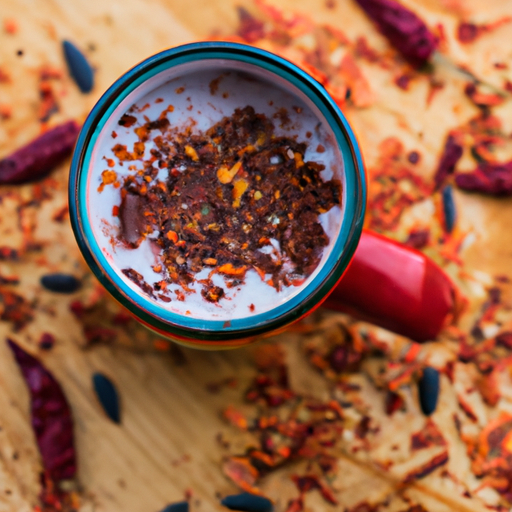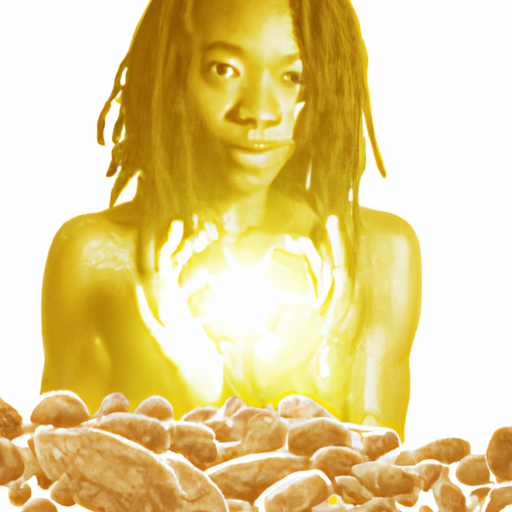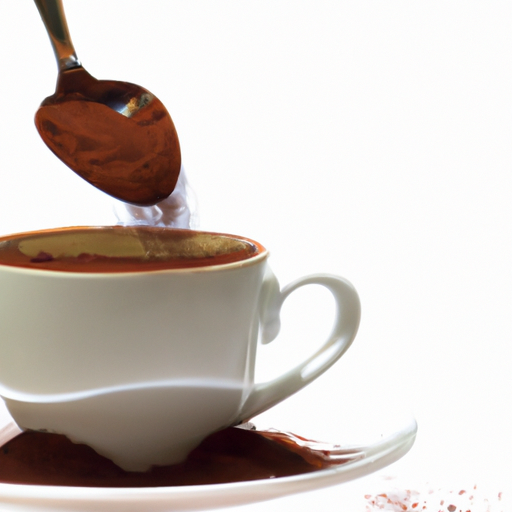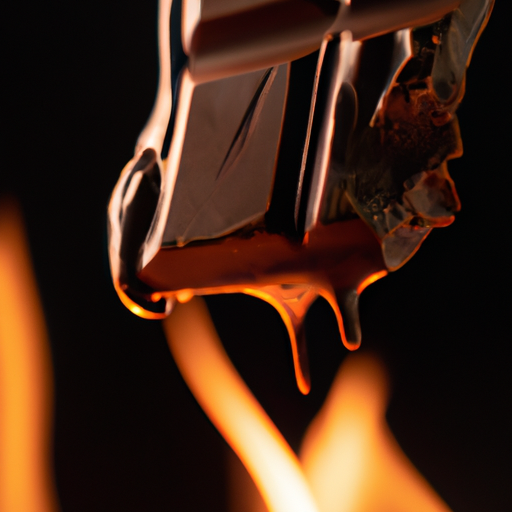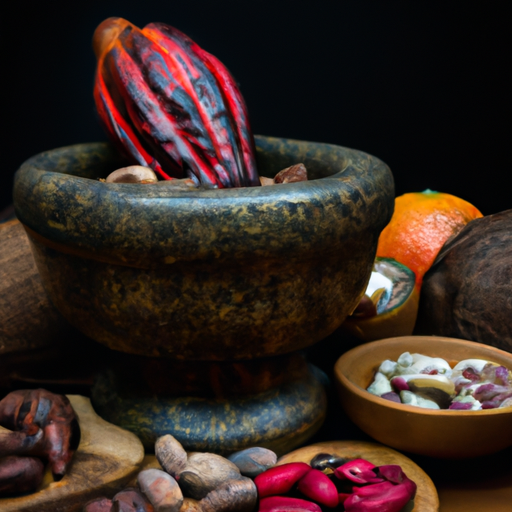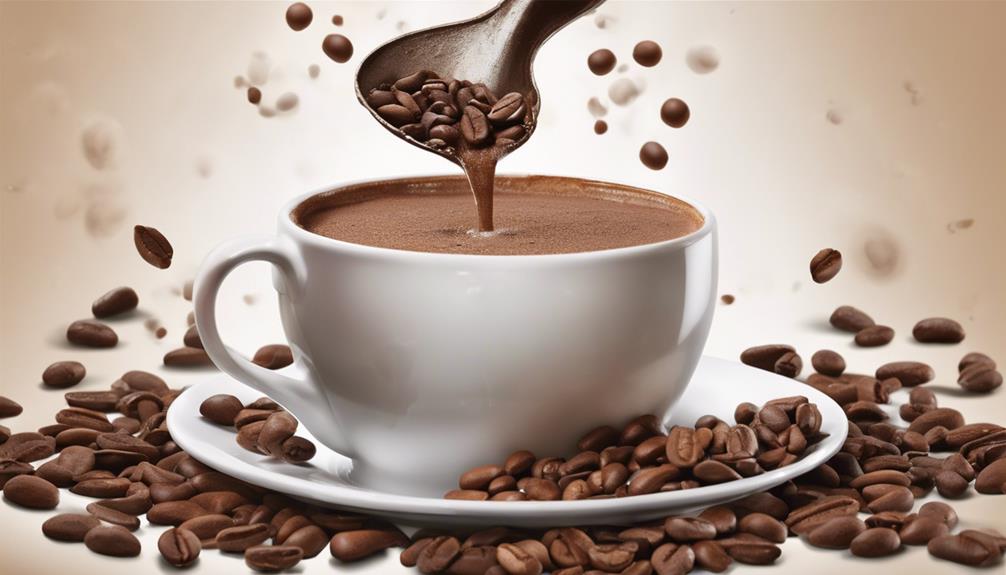As the popular saying goes, ‘You are what you eat.’ And if that proves true, then I aspire to embody the qualities of a soothing cup of raw cacao hot chocolate. Raw cacao, frequently praised as a superfood, is brimming with health perks that render it a tempting inclusion in any diet. From enhancing mood and boosting energy to promoting heart health and diminishing inflammation, this delightful indulgence has a myriad of benefits to provide.
But how exactly do you drink raw cacao? In this article, I will guide you through the ins and outs of incorporating raw cacao into your daily routine. Whether you’re sipping on a velvety smooth hot chocolate, blending it into a nutritious smoothie, or indulging in a decadent dessert, there are countless ways to enjoy the rich, chocolatey goodness of raw cacao.
So grab your favorite mug and get ready to dive into the world of raw cacao, one delicious sip at a time.
Key Takeaways
- Raw cacao can be used to create mole sauce, adding depth and complexity to Mexican dishes.
- Raw cacao can be blended with fruits, nuts, and coconut water to make a nutrient-packed smoothie.
- It is important to look for organic and fair trade certified raw cacao brands to ensure sustainability and ethical sourcing.
- Raw cacao retains more nutrients and antioxidants compared to processed cacao, offering health benefits such as improved skin elasticity and reduced inflammation.
Explore the Health Benefits of Raw Cacao
Discover the incredible health benefits of raw cacao as you indulge in its rich, decadent flavor.
Raw cacao is not only a delicious treat, but it also offers numerous benefits for your heart health.
Packed with antioxidants, raw cacao can help lower blood pressure, reduce inflammation, and improve blood flow, all of which contribute to a healthier heart.
Additionally, raw cacao contains compounds that boost serotonin and endorphin levels in the brain, promoting mental well-being and reducing stress.
Its mood-enhancing properties can help improve focus, increase feelings of happiness, and even alleviate symptoms of depression.
So, when you choose to incorporate raw cacao into your diet, not only are you satisfying your taste buds, but you are also nourishing your heart and supporting your mental well-being.
Choose the Right Raw Cacao Products
Find the perfect raw cacao products that suit your taste buds like a warm embrace from a long-lost friend. When exploring cacao alternatives, it’s important to understand the different processing methods used.
Look for organic, fair-trade cacao products that are minimally processed to maintain the maximum amount of nutrients and antioxidants.
Consider trying raw cacao nibs, which are small pieces of crushed cacao beans that add a crunchy texture to your dishes.
Raw cacao powder is another great option, perfect for making smoothies or baking.
And if you’re craving something sweeter, raw cacao chocolate bars are a delicious treat.
These options will allow you to enjoy the rich flavors and health benefits of raw cacao.
In the next section, we’ll explore how to make a delicious cup of raw cacao hot chocolate.
Make a Delicious Cup of Raw Cacao Hot Chocolate
Indulge in the velvety richness of a homemade cup of hot chocolate made with raw cacao powder. Not only does it satisfy your chocolate cravings, but it also offers a range of health benefits.
Raw cacao is packed with antioxidants, magnesium, and iron, which can help boost your mood and support heart health.
To make a delicious cup of raw cacao hot chocolate, simply heat your favorite milk (dairy or plant-based), add a tablespoon of raw cacao powder, and sweeten to taste with a natural sweetener like maple syrup or honey. Stir well until the powder is fully dissolved and enjoy the comforting warmth of this decadent drink.
If you want to explore more ways to incorporate raw cacao into your diet, try different recipes like raw cacao smoothies that are both nutritious and delicious.
Transitioning into the next section, let’s now move on to creating nutritious raw cacao smoothies.
Create Nutritious Raw Cacao Smoothies
When creating nutritious raw cacao smoothies, I always blend them with a combination of fruits and greens to pack in the vitamins and minerals. This not only adds a refreshing taste, but also provides a boost of energy throughout the day.
To enhance the smoothie’s staying power, I often add protein powders or nut butters which provide sustained energy and help keep me full for longer periods of time.
Lastly, I like to experiment with different flavors and textures by adding ingredients like coconut milk, almond extract, or chia seeds to create a unique and delicious smoothie experience.
Blend with Fruits and Greens
Mixing raw cacao with a vibrant assortment of fruits and greens is like creating a deliciously nutritious smoothie that will leave you feeling refreshed and energized. Here are five ways to incorporate raw cacao into your fruit smoothies and green smoothies:
- Blend raw cacao with bananas for a creamy and chocolatey treat.
- Add spinach or kale to your smoothie for an extra boost of vitamins and minerals.
- Mix in berries like strawberries or blueberries for a burst of antioxidants.
- Try adding avocado for a creamy texture and healthy fats.
- Experiment with other fruits like mango or pineapple for a tropical twist.
By blending raw cacao with fruits and greens, you not only satisfy your sweet tooth but also provide your body with essential nutrients.
In the next section, I will discuss how to add protein powders or nut butters for sustained energy.
Add Protein Powders or Nut Butters for Sustained Energy
Enhance your smoothie experience by adding protein powders or nut butters. These additions give your body a sustained energy boost that will keep you going all day long.
Protein powders are a great addition to raw cacao drinks. They provide the necessary amino acids for muscle repair and growth. Additionally, they help to stabilize blood sugar levels, keeping you feeling fuller for longer.
Nut butters, such as almond or peanut butter, add a creamy texture to your smoothie. They also provide healthy fats and protein, further enhancing the nutritional value of your drink.
This combination of protein powders and nut butters in your raw cacao drink will not only provide sustained energy but also support your overall health and well-being.
Now, let’s transition to the next step and experiment with different flavors and textures to make your raw cacao drink even more delicious.
Experiment with Different Flavors and Textures
Get ready to tantalize your taste buds with a variety of flavors and textures, taking your raw cacao drink to a whole new level of deliciousness.
When it comes to flavor combinations, the possibilities are endless. You can add a hint of vanilla extract for a sweet and aromatic twist, or a sprinkle of cinnamon for a warm and cozy flavor. For those who love a bit of spice, try adding a dash of cayenne pepper or a pinch of chili powder.
As for texture pairings, you can experiment with adding a dollop of coconut cream for a creamy and rich mouthfeel, or some crushed nuts for a crunchy texture.
Don’t be afraid to get creative and mix and match different flavors and textures to find your perfect combination.
And now, let’s indulge in raw cacao desserts!
Indulge in Raw Cacao Desserts
Feast upon the divine ecstasy of raw cacao desserts, and let your taste buds dance in rapturous delight. Raw cacao is not only a delectable treat, but it also offers numerous benefits for your skin and energy levels. Indulging in raw cacao desserts can provide a natural boost of energy, thanks to its high content of antioxidants and stimulants like theobromine. Additionally, raw cacao contains nutrients that promote healthy skin and can improve its appearance. To give you an idea of the delightful options available, here is a table showcasing some mouthwatering raw cacao desserts:
| Dessert | Description |
|---|---|
| Raw Cacao Brownies | Rich, fudgy treats made with raw cacao and nuts |
| Chocolate Mousse | Silky smooth mousse made with avocado and cacao |
| Raw Cacao Truffles | Decadent bite-sized delights rolled in coconut |
By incorporating raw cacao desserts into your routine, you can enjoy a sweet and indulgent treat while reaping the benefits for your energy and skin. Now, let’s explore how to incorporate raw cacao in your everyday cooking.
Incorporate Raw Cacao in Your Everyday Cooking
Transform your everyday meals into culinary masterpieces by incorporating the irresistible depth and richness of raw cacao.
Raw cacao is not just limited to desserts; it can also add a unique twist to savory dishes. Explore the world of culinary possibilities by using raw cacao in unexpected ways.
For example, you can create a rich and velvety mole sauce by combining raw cacao with spices, nuts, and chilies. This complex flavor profile adds a depth and complexity to your favorite Mexican dishes.
Additionally, you can experiment with raw cacao infused drinks for a refreshing twist. Try blending raw cacao with fruits, nuts, and coconut water for a nutrient-packed smoothie that will satisfy your chocolate cravings.
Discover raw cacao recipes from around the world and unlock a whole new level of culinary creativity.
Discover Raw Cacao Recipes from Around the World
Indulge in a culinary journey around the globe as you explore the diverse and delectable raw cacao recipes from different cultures.
Raw cacao is not only used in sweet treats but also finds its way into traditional beverages and savory dishes. In Mexico, for example, you can savor the rich and frothy taste of homemade hot chocolate made from raw cacao beans, while in Ghana, you can try the flavorful and spicy cocoa-based stew known as ‘groundnut soup.’
Raw cacao’s versatility is truly remarkable, as it adds depth and complexity to various cuisines. From the velvety smoothness of a raw cacao smoothie in Brazil to the tangy kick of raw cacao mole sauce in Mexico, the possibilities are endless.
So get ready to tantalize your taste buds with these global raw cacao creations.
Now, let’s learn about sustainability and ethical sourcing of raw cacao.
Learn About Sustainability and Ethical Sourcing of Raw Cacao
Immerse yourself in the realm of sustainability and ethical sourcing as you delve into the intricate practices surrounding the cultivation and procurement of raw cacao. Sustainable farming practices are essential for the long-term viability of cacao production. Farmers who implement these practices focus on preserving biodiversity, conserving water, and reducing the use of pesticides and fertilizers. Additionally, fair trade certification ensures that farmers receive fair prices for their products, improving their livelihoods and supporting their communities. By choosing cacao products with fair trade certification, you can contribute to a more equitable and sustainable supply chain. To better understand the impact of sustainable farming and fair trade certification, take a look at the table below:
| Sustainable Farming Practices | Fair Trade Certification | Impact |
|---|---|---|
| Organic farming methods | Ensures fair prices | Reduces harm to the environment |
| Conservation of biodiversity | Supports farmers’ | Improves livelihoods |
| Water conservation | Provides community support | Promotes social justice |
As you explore the world of sustainable and ethically sourced raw cacao, you will gain a deeper appreciation for the positive impact it has on both the environment and the communities involved. Now, let’s move on to the next section and experiment and have fun with raw cacao.
Experiment and Have Fun with Raw Cacao
When it comes to experimenting and having fun with raw cacao, I love trying different brands and varieties to see which ones I enjoy the most.
Mixing raw cacao with other superfoods like maca or spirulina adds an extra boost of health benefits and flavor to my creations.
And of course, sharing my raw cacao creations with friends and family is always a joy as we discover new and delicious ways to enjoy this nutrient-rich ingredient.
Try Different Raw Cacao Brands and Varieties
Explore various raw cacao brands and varieties to discover the perfect one that suits your taste buds. Raw cacao is different from processed cacao as it retains more of its natural nutrients and antioxidants. It is packed with flavonoids that can benefit the skin by improving elasticity and reducing inflammation. When choosing a raw cacao brand, look for those that are organic and fair trade certified to ensure ethical and sustainable sourcing. To make the selection process easier, I have created a table comparing four popular raw cacao brands and their unique characteristics:
| Brand | Variety | Taste | Price |
|---|---|---|---|
| Brand A | Criollo | Smooth and fruity | $$ |
| Brand B | Forastero | Bold and bitter | $ |
| Brand C | Trinitario | Balanced and nutty | $$$ |
| Brand D | Nacional | Rich and earthy | $$ |
By trying different brands and varieties, you can find the raw cacao that best suits your preferences. Now, let’s move on to the next section and explore how to mix raw cacao with other superfoods.
Mix Raw Cacao with Other Superfoods
After trying different raw cacao brands and varieties, I discovered that mixing raw cacao with other superfoods can take its taste and nutritional benefits to a whole new level. Combining raw cacao with superfoods like maca, chia seeds, or goji berries not only adds a delightful twist but also boosts the overall nutritional value of the drink.
These superfood combinations offer a powerhouse of antioxidants, vitamins, and minerals that can support overall health and wellbeing. Additionally, raw cacao has been known for its benefits for the skin, thanks to its high content of antioxidants and flavonols. These compounds can help improve skin elasticity, reduce inflammation, and promote a healthy glow.
So, by incorporating raw cacao into your superfood creations, you not only enhance the taste but also give your skin an extra dose of nourishment.
Now, let’s move on to the next section and see how you can share your raw cacao creations with friends and family.
Share Your Raw Cacao Creations with Friends and Family
To share your delicious creations made with raw cacao, invite your loved ones over and let them indulge in the irresistible flavors and health benefits of these superfood treats.
Did you know that sharing meals with family and friends has been shown to strengthen relationships and improve overall well-being?
Raw cacao not only adds a rich and decadent flavor to your creations, but it also offers numerous health benefits. As a natural remedy, raw cacao contains antioxidants that can help reduce inflammation, improve heart health, and boost mood.
Additionally, raw cacao is also used in skincare products due to its high levels of antioxidants and minerals, which can nourish and protect the skin.
So, why not share the goodness of raw cacao with your loved ones and enjoy the benefits together?
Frequently Asked Questions
Can I consume raw cacao directly without any preparation?
Yes, you can consume raw cacao directly without any preparation. Raw cacao is packed with antioxidants and offers various health benefits like improved mood and heart health. There are also many delicious raw cacao recipes available.
How much raw cacao should I consume in a day to reap its health benefits?
To reap the health benefits of raw cacao, it is recommended to consume a moderate amount daily. Research suggests that consuming 1-2 tablespoons of raw cacao powder or nibs can provide antioxidant properties and potentially improve heart health.
Can I add sweeteners to my raw cacao drink?
Yes, you can add sweeteners to your raw cacao drink. However, it’s important to choose healthier options like raw honey or stevia. Alternatively, you can enhance the flavor with spices like cinnamon or vanilla extract.
Are there any side effects of consuming raw cacao?
There’s an adage that says "everything in moderation." While raw cacao has numerous health benefits, it’s important to be aware of potential side effects such as digestive issues, increased heart rate, and migraines.
Are there any specific storage requirements for raw cacao products?
For optimal storage of raw cacao products, it is important to follow specific guidelines. It is recommended to store them in a cool, dry place away from direct sunlight to maintain their quality and extend their shelf life.
– Is Drinking Raw Cacao the Only Way to Use It?
Yes, drinking raw cacao is not the only way to use it. There are many delicious raw cacao recipe ideas for making desserts, smoothies, and even savory dishes. Try incorporating raw cacao into your cooking for a delicious and nutritious boost.
Conclusion
In conclusion, drinking raw cacao can be a delightful and nutritious experience. By exploring its health benefits and incorporating it into various recipes, we can unlock its potential.
Raw cacao is like a warm hug for your taste buds, providing a rich and indulgent flavor that will leave you feeling satisfied.
With its sustainable and ethical sourcing practices, you can enjoy raw cacao with a clear conscience.
So go ahead, embrace the world of raw cacao and let it bring joy to your everyday life.

